Ultra-high Capacity Wireless Communication by Means of Infrared Optical Beams
Ton Koonen, Ketemaw Mekonnen, Frans Huijskens, Zizheng Cao, and Eduward Tangdiongga, Eindhoven University of Technology, The Netherlands
IEEE Future Networks Tech Focus, Volume 3, Issue 2, September 2019
Abstract
Optical wireless communication is well positioned to resolve congestion in the radio spectrum caused by the booming wireless traffic demands. Two-dimensionally steerable infrared beams can provide ultra-high capacity wireless communication to many users individually. The narrow beam size enables tight spatial re-use, hence a huge data throughput. We demonstrated an indoor system providing up to 128 beams, with a capacity up to 112 Gbit/s per beam. Its on-demand highly-localized delivery scheme yields energy-efficient operation, assures enhanced privacy, and minimizes latency. It can off-load high data-rate traffic from WiFi networks, which thus get ample room to host the numerous internet-of-things devices.
1. Introduction
We are getting ever more dependent on the Internet, both in our professional and in our daily life. We want to have access always and everywhere, to our e-mail, social networks, cloud storage, and a plethora of other services. And we do prefer this access by wireless means, as we cherish to move freely and to stay always-connected by means of smartphone, laptop, tablet computer and alike. Also the myriad of small apparatus in our direct environment (the ‘Internet of Things’) requires wireless access, for numerous machine-to-machine and machine-to-human communications. Presently, the public mobile 4G networks and local WiFi networks are trying to meet these demands; in the near future, 5G networks are coming and promise high capacity and low latency under heavy traffic loads.
Notwithstanding steady progress in radio technologies, e.g., by introducing a range of complex signal processing techniques, radio technologies are getting more and more exhausted in their quest to keep up with the staggering growth of wireless service demands. We often get only poor access, or even no access at all. Each of the antenna stations has to serve a certain area, and the many users in that area even have to share the scarce radio spectrum resources. New spectrum windows are looked for, e.g., by opening up the mm-wave and sub-TeraHertz spectrum bands, but also these can offer only limited relief. A hampering access can not only mean slower downloads and on-line games at home, but also faltering security systems such as fire alarms, failing patient monitoring systems in hospitals and elderly-care homes, malfunctioning robots in industry, collisions among autonomic driving cars, etc., and hence many possibly life-threatening risks.
2. Optical wireless communication
Cooper’s Law [1] has already stated that the key to exponential growth of wireless capacity is the creation of networks consisting of pico-cells, i.e., cells served by an antenna which are so small that the antenna has to serve only a few (or even a single) user. In order to avoid a mushrooming of antennas everywhere, with the inherent necessity of an extremely-dense (wired) backbone network to deliver the services to them, each antenna should create a multitude of pico-cells itself by sending out multiple narrow beams. Massive MIMO antenna systems using mm-waves and deploying massive amounts of antenna elements are being investigated for this.
Optical technologies par excellence can precisely address the pressing needs for opening more spectrum and creating smaller cells: the visible light spectrum from 400 to 700 nm implies no less than 320THz (!) of bandwidth, and the infrared spectrum of 1500 to 1600 nm some 12.5 THz, far more than achievable with radio techniques [2][3]. In addition, optical beamforming, e.g. by means of lenses and mirrors, can yield much smaller cells than attainable with mm-waves. High-speed optical devices for the 1500-1600 nm range are already mature and amply available as they are the workhorses for our worldwide-down-to-local fiber-optic networks. And as a bonus, infrared light beyond 1400 nm is ‘eye-safe’, implying that infrared beams are safe to use as long as their power is less than 10mW; with such power levels a link budget can be realized which easily enables more than 10Gbit/s per beam… As Einstein already stated, nothing is faster than light in vacuum (and open air), so the latency of light beam links is considerably lower than that of silica fiber links. And as there is no waveguiding mechanism in free space, the light beams also do not suffer from waveguide dispersion, so can fundamentally have even a higher bandwidth than an optical fiber.
3. Optical wireless communication by narrow infrared beams
For all the above-mentioned reasons, at Eindhoven University of Technology we pursue optical wireless communication by means of narrow infrared optical beams, so-called ‘pencil beams’ [2]. Each beam is so small that it serves a single user device, hence the user gets the full capacity of that beam, exclusively, and does not need to share it. Once he got a beam, he should not experience congestion problems. We proposed an indoor high-capacity wireless system concept as illustrated in Fig. 1. An indoor fiber network acts as the backbone, connecting the pencil beam radiating antenna (PRA) elements mounted at the ceiling of each room to the central communication controller (CCC) unit which interfaces to the outdoor access network. Each room has at least two PRA-s, in order to circumvent possible blocking of the line-of-sight to a mobile device. At the CCC, all the conditioning of the data signals and the beam-steering control is done.
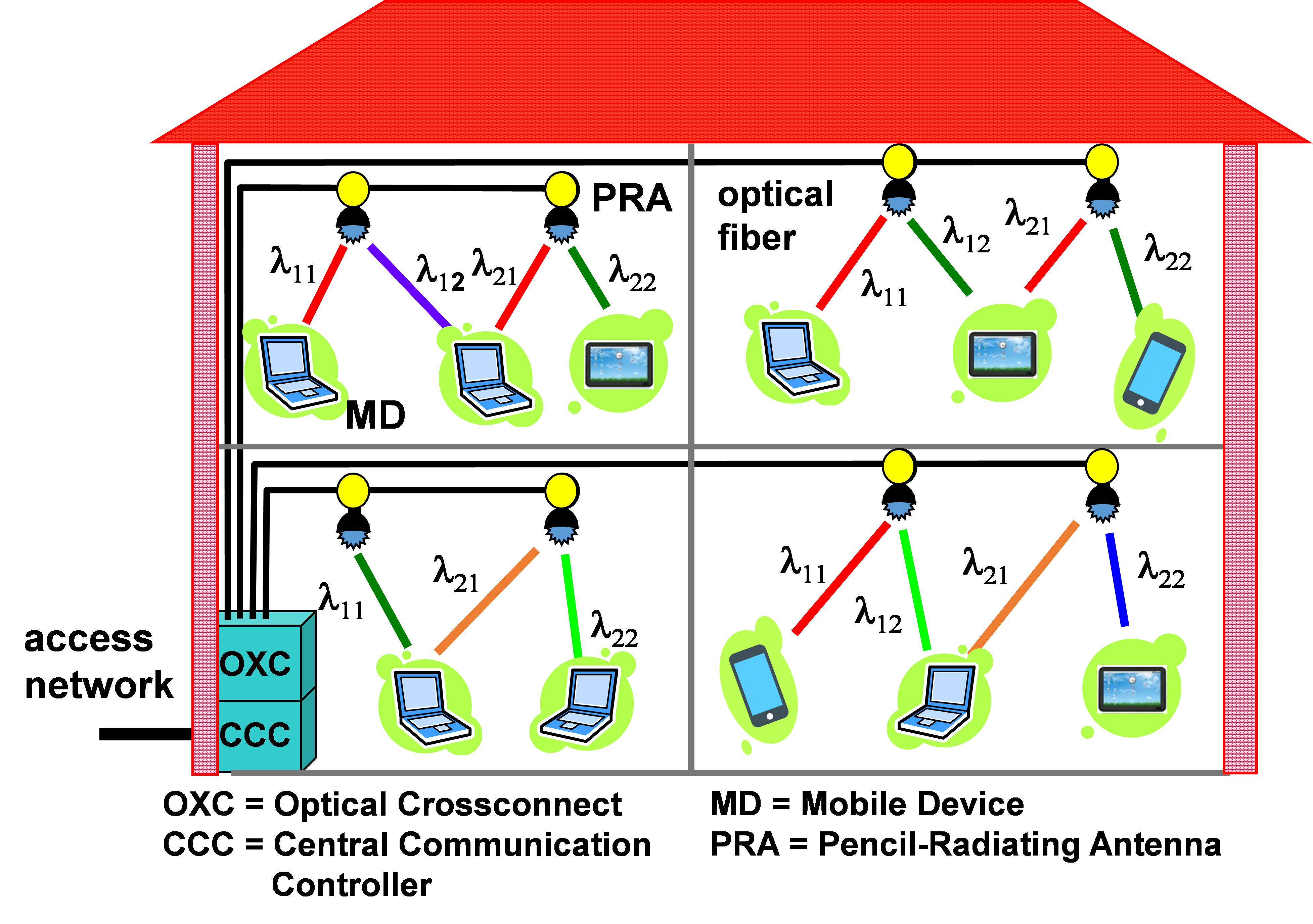
Figure 1. Indoor communication network using steered narrow optical beams
For the PRA, we developed diffractive passive modules which can steer a beam without needing a separate control line. They also do not need any moving parts and/or active electro-mechanical actuators. By means of a pair of gratings which are arranged orthogonally with respect to each other, the beam’s direction is altered in two dimensions by just changing its wavelength, as shown in Fig. 2 [2]. The optical signals carrying the data are fed to the module by means of an optical fiber, where each wavelength carrier is delivering its data to a beam in the direction specifically connected to that wavelength. Generating many beams just requires bringing many wavelength carriers to the module; scaling-up the system does not require the module itself to be changed. With other beam-steering techniques reported, such as those using MEMS mirrors or spatial light modulators (SLM-s), scaling to more beams requires the module to be scaled-up as well. Moreover, our diffractive beam-steering module concept implies that the control signal (being the wavelength) at the same time is the carrier of the data signal. In other words, the control channel is embedded in the data channel and no comprehensive bookkeeping needs to be done in order to keep them together; this can ease network management and control considerably. In the laboratory, we showed 42.8 Gbit/s transmission per beam over 2.5 meters [4].

Figure 2. Two-dimensional wavelength-tuned beam steering with a pair of crossed gratings
Next to our passive beam-steering concept building on a pair of crossed diffraction gratings, we also developed a concept with the same functionality building on an optical arrayed waveguide grating router, which is a well-known wavelength demultiplexer with a common input feeder fiber and a large number of output ports [5] . Such devices are well-known in fiber-optic networks in order to establish multi-wavelength transmission links and signal routers. In our concept, the many output fibers are arranged in a square two-dimensional fiber array, and this array is put in front of a lens with high aperture; see Fig. 3. The position of a fiber with respect to the lens determines the two-dimensional direction in which the collimated beam after the lens will go; therefore again each wavelength in the input feeder fiber is translated into a narrow beam into a specific direction. Using a high port count wavelength demultiplexer operating in the C- and L-band, we showed that 128 beams can be active simultaneously, where up to now capacities up to 112 Gbit/s per beam have been demonstrated employing PAM-4 modulation [6].
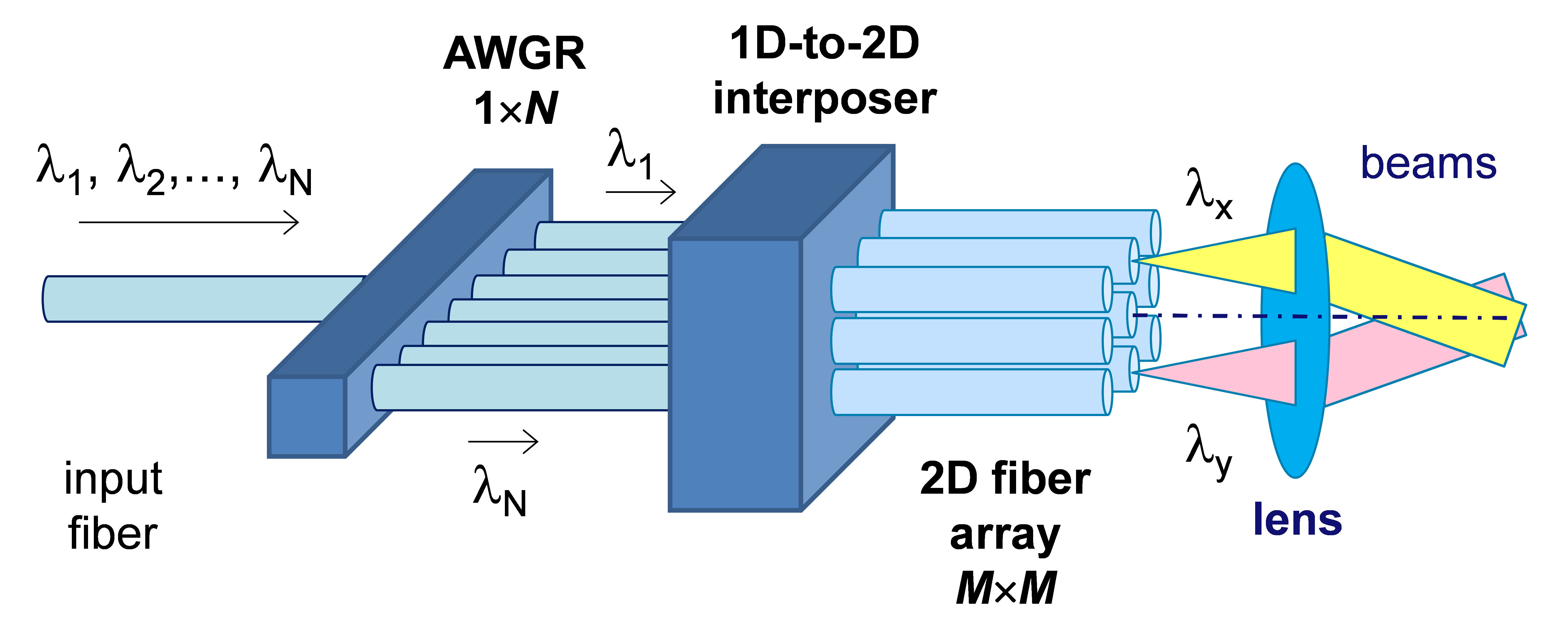
Figure 3. 2D beam steering with high port count Arrayed Waveguide Grating Router
We expanded this concept into a demonstrator setup in our laboratories [5]. We implemented a localization process too, in order to determine the position of the users’ devices and with this position information adjust the wavelengths of the tunable laser transmitters in the central controller site such that the respective beams are directed accurately to the specific user devices. We showed the simultaneous real-time transmission of two high-definition video channels each embedded in a 10 Gbit/s Ethernet stream, which were received independently by two closely spaced user units. The setup is shown in Fig. 4.
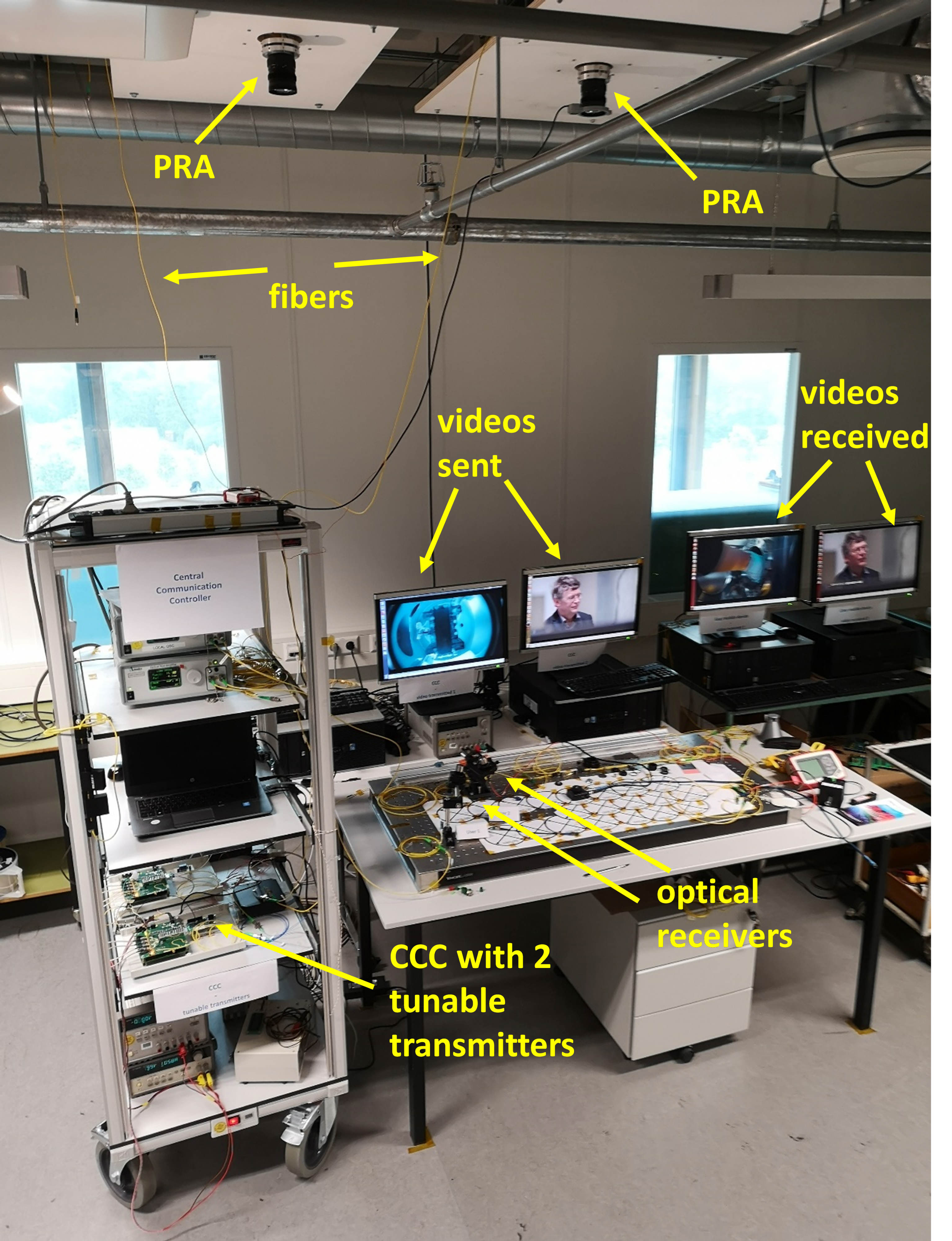
Figure 4. Laboratory setup
4. Applications
With our infrared beam-steered optical communication technology, we can provide ultra-high capacity wireless data transmission where the narrow beams can offer enhanced privacy (as the neighboring users do not get the beam, so cannot listen in) and energy-lean operation (as the beams are directed only to those places where and when needed). They can actually offer every individual the benefits of a single fiber without the need of being physically connected to a fiber.
This technology may disclose the opportunities for new highly-demanding applications such as 8K ultra-high definition wireless video streaming, real-time virtual reality gaming or training without being hampered by wires, tele-presence meetings, etc . It can offer distinct advantages in environments such as in exhibition halls with frequently changing constellations of independent booths (which do not like capacity sharing), in electromagnetic radiation-sensitive areas (such as intensive care and surgery rooms in hospitals, inside airplanes, …), in airport waiting areas near the gate (where people want to do fast downloading or other voluminous internet things before getting on board), between racks inside data centers (where it provides minimum latency, as light travels 50% faster in air than in silica fiber), etc.
5. Concluding remarks
By means of 2D-steerable narrow infrared beams, very high capacity wireless connections can be created to users individually. These connections are established on-demand, only there where and when needed; thus they are congestion-free, energy-efficient, and provide a high level of privacy as well as minimum latency. The narrow beams create very small cells, which enables tightly-packed spatial re-use and thus yields a huge data throughput of the wireless system. In our demonstrator, we can create 128 beams, and showed 112Gbit/s capacity per beam.
Acknowledgment
Our research is done in the project BROWSE – Beam-steered Reconfigurable Optical-Wireless System for Energy-efficient communication, which received funding from the European Research Council in their Advanced Investigator Grant program, and in the follow-up proof-of-concept project BROWSE+.
References
- http://www.arraycomm.com/technology/coopers-law/
- A.M.J. Koonen, “Indoor optical wireless systems: technology, trends, and applications,” J. Lightw. Technol., vol. 36, no. 8, Apr. 2018, pp. 1459-1467. DOI 10.1109/JLT.2017.2787614.
- A. M. J. Koonen, “Optical wireless systems: Technology, trends and applications,” in Proc. Int. Conf. IEEE Photon. Webinar, Feb. 2018. [Online]. Available: https://www.photonicssociety.org/educationcareers/webinars/optical-wireless-communication-webinar [5]
- C.W. Oh, E. Tangdiongga, A.M.J. Koonen, "42.8 Gbit/s indoor optical wireless communication with 2-dimensional optical beamsteering", in Proc. OFC2015, Los Angeles, March 22-26, 2015, paper M2F.3.
- A.M.J. Koonen, F. Gomez-Agis, F.M. Huijskens, K.A. Mekonnen, Z. Cao, E. Tangdiongga, “High-capacity optical wireless communication using two-dimensional IR beam steering,” J. Lightw. Technol., vol. 36, no. 19, Oct. 2018, pp. 4486-4493. DOI 10.1109/JLT.2018.2834374
- F. Gomez-Agis, S. P. van der Heide, C. M. Okonkwo, E. Tangdiongga and A. M. J. Koonen, “112 Gbit/s transmission in a 2D beam steering AWG-based optical wireless communication system”, in Proc. ECOC2017, Göteborg, Sweden, Sept. 17-21, 2017, Paper Th.2.B.1.
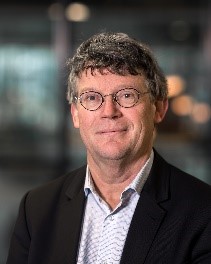 Ton Koonen (IEEE F’07, OSA F’13) is full professor in Eindhoven University of Technology (TU/e) since 2001. Since 2004, he is chairman of the group Electro-Optical Communication Systems, and since 2012 vice-dean of the department Electrical Engineering. Since 2016, he also is Scientific Director of the Institute for Photonic Integration at TU/e. Before 2001, he worked for more than 20 years in applied research in industry, amongst others in Bell Labs - Lucent Technologies. Ton Koonen is a Bell Labs Fellow (1998), IEEE Fellow (2007), OSA Fellow (2013), and Distinguished Guest Professor of Hunan University, Changsha, China (2014). In 2011, he received an Advanced Investigator Grant of the European Research Council on optical wireless communication. His current research interests are optical fiber-supported in-building networks (including optical wireless communication techniques, radio-over-fiber techniques, and high-capacity plastic optical fiber (POF) techniques), optical access networks, and spatial division multiplexed systems.
Ton Koonen (IEEE F’07, OSA F’13) is full professor in Eindhoven University of Technology (TU/e) since 2001. Since 2004, he is chairman of the group Electro-Optical Communication Systems, and since 2012 vice-dean of the department Electrical Engineering. Since 2016, he also is Scientific Director of the Institute for Photonic Integration at TU/e. Before 2001, he worked for more than 20 years in applied research in industry, amongst others in Bell Labs - Lucent Technologies. Ton Koonen is a Bell Labs Fellow (1998), IEEE Fellow (2007), OSA Fellow (2013), and Distinguished Guest Professor of Hunan University, Changsha, China (2014). In 2011, he received an Advanced Investigator Grant of the European Research Council on optical wireless communication. His current research interests are optical fiber-supported in-building networks (including optical wireless communication techniques, radio-over-fiber techniques, and high-capacity plastic optical fiber (POF) techniques), optical access networks, and spatial division multiplexed systems.
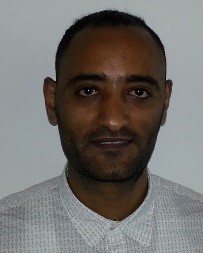 Ketemaw Addis Mekonnen (IEEE S’15) received the B.Sc. degree in electrical engineering from Mekelle University, Ethiopia, in 2007. He received the double M.Sc. degree in the Erasmus Mundus Master on photonic networks engineering program from Scuola Superiore Sant’Anna, Italy, and Aston University, U.K., in 2013. He obtained the Ph.D. degree in Eindhoven University of Technology, The Netherlands, in 2018. His current research interests include dynamic optical routing, radio over fiber, signal processing, and optical wireless communication.
Ketemaw Addis Mekonnen (IEEE S’15) received the B.Sc. degree in electrical engineering from Mekelle University, Ethiopia, in 2007. He received the double M.Sc. degree in the Erasmus Mundus Master on photonic networks engineering program from Scuola Superiore Sant’Anna, Italy, and Aston University, U.K., in 2013. He obtained the Ph.D. degree in Eindhoven University of Technology, The Netherlands, in 2018. His current research interests include dynamic optical routing, radio over fiber, signal processing, and optical wireless communication.
 Frans Huijskens graduated in applied physics at the Technical College of Dordrecht, The Netherlands, in 1979. From 1981 to 1984, he was an Electronic Test Engineer at Siemens Gammasonics. In 1985, he joined the Electro-Optical Communications Group of Eindhoven University of Technology. He worked on passive fiber couplers, on phase- and polarization-diversity coherent systems, on demonstrator setups of optical cross-connecting and optical packet switching, and on packaging of optical integrated devices. Recently he has focused on demonstrator setups of optical wireless communication.
Frans Huijskens graduated in applied physics at the Technical College of Dordrecht, The Netherlands, in 1979. From 1981 to 1984, he was an Electronic Test Engineer at Siemens Gammasonics. In 1985, he joined the Electro-Optical Communications Group of Eindhoven University of Technology. He worked on passive fiber couplers, on phase- and polarization-diversity coherent systems, on demonstrator setups of optical cross-connecting and optical packet switching, and on packaging of optical integrated devices. Recently he has focused on demonstrator setups of optical wireless communication.
 Zizheng Cao (IEEE S’11, M’15) received the M.Eng. degree in telecom engineering (awarded “Outstanding thesis of master degree” of Hunan Province) from Hunan University, Changsha, China, in 2010. He received the Ph.D. degree (Cum Laude) from Eindhoven University of Technology (TU/e) in 2015. Since then he is working at TU/e, where he currently is Assistant Professor. His research interests include integrated photonics circuits, microwave photonics, advanced DSP, and optical wireless communication. He received a Graduate Student Fellowship of IEEE Photonics Society in 2014. He holds two Chinese patents and two US provisional patents.
Zizheng Cao (IEEE S’11, M’15) received the M.Eng. degree in telecom engineering (awarded “Outstanding thesis of master degree” of Hunan Province) from Hunan University, Changsha, China, in 2010. He received the Ph.D. degree (Cum Laude) from Eindhoven University of Technology (TU/e) in 2015. Since then he is working at TU/e, where he currently is Assistant Professor. His research interests include integrated photonics circuits, microwave photonics, advanced DSP, and optical wireless communication. He received a Graduate Student Fellowship of IEEE Photonics Society in 2014. He holds two Chinese patents and two US provisional patents.
 Eduward Tangdiongga (IEEE S’01, M’10) received the M.Sc. and Ph.D. degrees from the Eindhoven University of Technology, The Netherlands, in 1994 and 2001, respectively. In 2001, he joined COBRA Research Institute working on ultrafast optical signal processing using semiconductor devices. In 2016, he became an Associate Professor on advanced optical access and local area networks. His current research interests include passive optical networks, radio over (single mode-, multimode-, and plastic) fiber, and optical wireless communication.
Eduward Tangdiongga (IEEE S’01, M’10) received the M.Sc. and Ph.D. degrees from the Eindhoven University of Technology, The Netherlands, in 1994 and 2001, respectively. In 2001, he joined COBRA Research Institute working on ultrafast optical signal processing using semiconductor devices. In 2016, he became an Associate Professor on advanced optical access and local area networks. His current research interests include passive optical networks, radio over (single mode-, multimode-, and plastic) fiber, and optical wireless communication.
Editor: Rod Waterhouse

Rod Waterhouse received his BEng, MS, and PhD in Electrical Engineering from the University of Queensland, Australia, in 1987, 1989 and 1994, respectively. In 1994 he joined RMIT University as a lecturer, became a Senior Lecturer in 1997 and an Associate Professor in 2002. From 2001 – 2003 Dr Waterhouse was with the venture-backed Dorsal Networks which was later acquired by Corvis Corporation. In 2004 he co-founded Pharad, an antenna and high performance RF-over-fiber technologies company of which he is the Chief Technology Officer. From 2003 he was also appointed as a Senior Fellow within the Department of Electrical and Electronic Engineering at the University of Melbourne. Dr Waterhouse’s research interests include antennas, electromagnetics and microwave photonics engineering. He has over 290 publications in these fields, including 2 books and 4 book chapters. Dr Waterhouse received the grade of IEEE Fellow for his work on printed antenna and microwave photonic technologies. Dr Waterhouse was an Associate Editor for IEEE AP Transactions during 2003 – 2009 and he is the Member at Large for IEEE Int. Topical Meeting on Microwave Photonics since 2016. Dr Waterhouse has been on the IEEE Photonics Society Fellow Evaluation Committee since 2013 and was a Representative of the IEEE Photonics Society for the National Photonics Initiative in 2015. In 2000, IEEE Third Millennium Medal for ‘Outstanding Achievements and Contributions’.
Subscribe to Tech Focus
Join our IEEE Future Networks Technical Community and receive IEEE Future NetworksTech Focus delivered to your email.
Article Contributions Welcome
Submit Manuscript via Track Chair
Author guidelines can be found here.
Other Future Networks Publications
IEEE Future Networks Tech Focus Editorial Board
Rod Waterhouse, Editor-in-Chief
Mithun Mukherjee, Managing Editor
Imran Shafique Ansari
Anwer Al-Dulaimi
Stefano Buzzi
Yunlong Cai
Zhi Ning Chen
Panagiotis Demestichas
Ashutosh Dutta
Yang Hao
Gerry Hayes
Chih-Lin I
James Irvine
Meng Lu
Amine Maaref
Thas Nirmalathas
Sen Wang
Shugong Xu
Haijun Zhang
Glaucio Haroldo Silva de Carvalho

